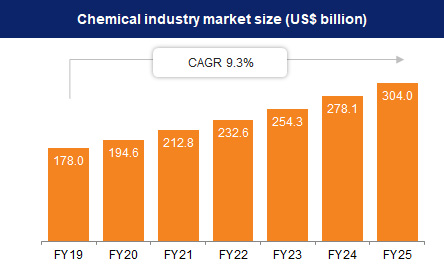Project Report For Chemical Industry
Introduction
Project report For chemical industry is as follows.
The chemical industry includes businesses that produce industrial chemicals. It has a crucial part modern economy. It has over 70,000 different goods from rudimentary materials (oil, natural gas, air, water, metals, and minerals). The chemical industry creates around 50,000 unique chemicals and formulations. One of the most important bulk chemicals in terms of energy is ethylene, which is used to make a variety of products, such as solvents and plastics.
A wide range of by products is also produced by several processes in the chemical industry. In the chemical industry, energy sources and raw materials including fuels and electricity are utilized. As a result, energy analysis in the chemical industry is more challenging than in other sectors. The chemical industry is a huge sector that includes all kinds of businesses that produce goods and whose production is heavily dependent on chemicals. Industries that produce industrial chemicals are frequently referred to as the chemical industry.

Chemical industries can be divided into many classes according to the final products, procedures, or raw materials they use. Given the enormous diversity of chemical-producing sectors, these industries are typically divided into broad groups such as manufacturing inorganic and organic chemicals, fertilizers, petroleum refining, electroplating, heat treatment, pesticides, hydro-generated oil/soap, etc.
The bulk of the energy used in the chemical industry is used by a limited number of bulk compounds. These so-called fundamental chemicals serve as the foundation for many other chemicals produced farther along the supply chain. The ethylene, propylene, butadiene, and benzene family of petrochemicals, as well as ammonia and chlorine/caustic soda from the inorganic chemical sector, are the most significant basic chemicals.
Project Report Sample On
Chemical Industry
Get Completely Custom Bankable Project Report
One of the key factors in the expansion and improvement of any economy is the chemical industry. So much so that the chemical industry serves as the backbone for the process of national development that the industrial development of any country is determined by the consumption of sulfuric acid.
Market Potential Of Chemical Industry
The Indian chemicals market was worth US$ 178 billion in 2019 and is projected to grow by 9.3% annually to US$ 304 billion by 2025. By 2025, the demand for chemicals is anticipated to increase by 9% annually. By 2025, it is anticipated that India’s chemical sector would contribute $300 billion to the country’s GDP.
Production of chemicals totaled 918,629 MT and that of petrochemicals 1,564,215 MT in April 2022. The level of chemical output was as follows. 263,867 MT of soda ash, 282,716 MT of caustic soda, 205,786 MT of liquid chlorine, 23,233 MT of formaldehyde, and 22,668 MT of pesticides and insecticides were used.
Small and medium-sized businesses in the domestic chemicals sector are anticipated to post 18–23% revenue growth in FY22, thanks to improved domestic demand and increased realization as a result of high chemical prices.
As a result, Indian specialized chemical companies are increasing their capacity to meet the growing domestic and international demand. The chemical industry in India has the potential for major growth once more, which would help create a safe and stable supply chain for the rest of the world.

The automated system permits 100% FDI and industrial licenses in the chemical industry, with a few limitations for hazardous materials. From April 2000 to December 2021, FDI inflows into the chemicals sector—excluding fertilizers—totaled US$19.09 billion.
The Panipat Refinery in Haryana will receive an investment of INR 3,681 crore (USD 495.22 million) from Indian Oil Corporation (IOCL) to build the nation’s first mega-scale maleic anhydride unit for the production of high-value specialty chemicals.
The production base of the Indian chemicals sector is diverse and generates products of the highest caliber. All segments have a sizable representation of the downstream industry. Additionally, this sizable and developing domestic chemical sector benefits from a big pool of highly qualified scientific labor.
